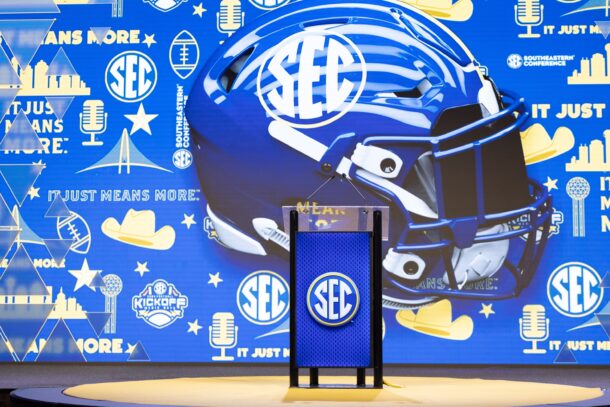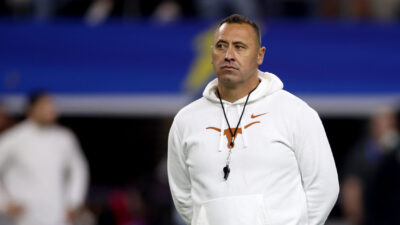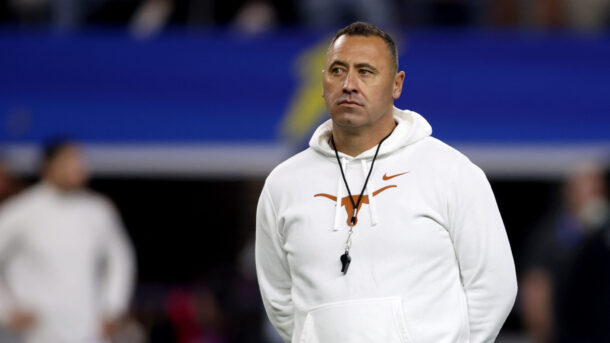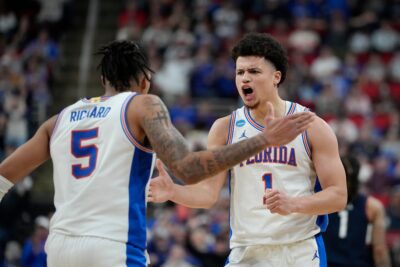Ad Disclosure
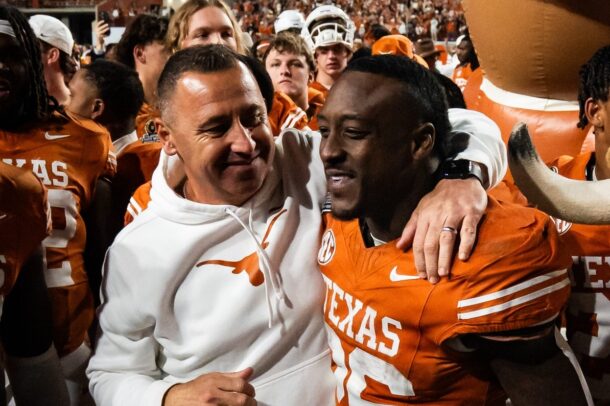
Cam Skattebo is unreal, but let’s appreciate what Steve Sarkisian has done with Texas’ backfield
If you tune into the Peach Bowl on New Year’s Day, your eyes will naturally become fixated on Cam Skattebo.
The Arizona State tailback is a 5-9 battering ram who could inspire nations with how he carries the football, both as a running back and as a pass-catcher (he’s also ASU’s leading receiver now that Jordan Tyson is out with a season-ending injury). I voted Skattebo No. 3 on my Heisman Trophy ballot and will argue to anyone that his impact on the Sun Devils, who won the Big 12 after being to picked to finish last in Year 1 of the new conference, is as great as anybody in the country.
But when all of us are finished praising ASU’s backfield sensation, let’s shift the attention to the backfield on the other side of the Peach Bowl. You know, the one that ran for 292 yards in a first-round victory against Clemson.
What Steve Sarkisian has done with this Texas backfield is among the most impressive feats of the year.
Wait, what’s impressive about signing top-5 classes and having the No. 49 rushing offense in FBS? How is that worthy of praise?
Well, go back to August. That was when the Longhorns lost CJ Baxter, who had 103 scrimmage yards in a Playoff game as a true freshman, and 4-star true freshman running back Christian Clark.
Mind you, that was on the heels of losing Jonathan Brooks, AKA the highest-drafted running back in April. Including the year before when the Longhorns lost Bijan Robinson, it was the second time in as many seasons that Sarkisian was tasked with replacing the top running back in an NFL Draft class. That’s not even including the loss of Roschon Johnson, who was selected by the Bears in the 4th round in the 2023 NFL Draft.
That’s a ton of turnover at the position in a year-plus. It was fair to wonder if the injury to Baxter, who was expected to be the lead back, would be a potential deterrent to a Texas national title.
I went back to August to find my take on that. It was a few weeks removed from when I predicted that Baxter would lead the SEC in rushing as a sophomore, and he would do so for a Texas team that would reach the national championship. Here’s what I wrote after that news broke:
“Do I believe Baxter’s absence will swing the Longhorns’ year that dramatically? No, but in this expanded Playoff, health will become an even bigger factor than in the 4-team era. Injury luck matters. There’s nothing lucky about watching a potential leading rusher in the SEC go down in the first week in August. If Texas is indeed on the outside looking in of the national title picture in late-December, Baxter’s injury will at least be part of that conversation. Texas’ climb will be a steeper one without Baxter.”
Yeah … about that.
Texas’ climb to the quarterfinals was made easier by the fact that it returned 4 of 5 starters on the offensive line, and up until that Kelvin Banks Jr. injury, the Longhorns had ideal continuity with that unit. But in a Playoff game in which 2 of the Longhorns’ offensive line starters went down, the only inevitable force was the ground game feasting against Clemson.
Jaydon Blue and Tre Wisner combined for 29 carries for 256 yards with 2 touchdowns apiece. True freshman Jerrick Gibson, who had 9 carries for 35 yards, also stepped in and had a key 4th-down conversion on the first drive of the game that led to a Texas touchdown.
That game marked the 9th time this year in which Texas hit 175 rushing yards. Compare that to another exceptionally talented team like Georgia, which had just 1 game hitting that mark all year … and it was vs. UMass. Texas did that without a run threat at quarterback. Quinn Ewers has been banged up with multiple injuries and perhaps he hasn’t best version of himself post-Michigan. It’s well-documented how rarely Texas stretched the field vertically. This season, 29.1% of Ewers’ passes stayed behind the line of scrimmage and 32.8% were between 0-9 yards (via PFF).
In other words, there’s more reason than expected to play near the line of scrimmage. Has it mattered? For the most part, it hasn’t.
On the surface, one could look at that and say it’s not a revelation that Blue turned into a weapon in Sarkisian’s offense. That’s what he became last year, especially after Brooks suffered a season-ending injury in November. But even Blue dealt with fumbling issues that limited him to 7 combined carries in pivotal late-season games against Texas A&M and Georgia. That opened the door for Wisner to be the hero against A&M with a career-high 207 scrimmage yards on a career-high 35 touches, and while Wisner had much tougher sledding against UGA in the SEC Championship rematch, he still got 22 touches. That’s a guy who played 22 snaps all last season when he was mostly a special teams player.
It’s a distant memory that Wisner, who is now Texas’ leading rusher, was expected to be 3rd or 4th in pecking order when the season began, depending on how Gibson developed. This is what Sarkisian does.
It’s easy to overlook that for outsiders because he’s never had a rushing attack that finished better than 25th in FBS. Some of that, I’d argue, is because teams at the top of the rushing ranks usually get significant help from a mobile quarterback. Ewers isn’t that guy.
But Sarkisian is the guy who elevated Texas’ floor in large part because of how he built up the Longhorns’ ground attack, both with his ability as a schemer and nailing his assistant hires like OL coach Kyle Flood (2021-present) and running backs coach Tashard Choice (2022-present). Any notion that Sarkisian’s expertise in developing an elite backfield would fade once Robinson left for the NFL — he was Texas’ first offensive player Drafted in the 1st round since Vince Young in 2006 — has since been proven wrong multiple times over.
On Wednesday when Texas lines up against Arizona State with a semifinal berth up for grabs, it’ll do so with an offensive line that might be a bit more banged up than it was at any point in the regular season (though Banks was back to his Outland Trophy-winning self in his return vs. Clemson). If that unit doesn’t quite repeat the Clemson blueprint against ASU run defense that ranks No. 28 in FBS against the run, that won’t be stunning, even as a 2-score favorite, via ESPN Bet.
Still, though. Don’t lose sight of how plug-and-play Texas’ ground attack has become. Maybe it won’t be the backbone of Texas’ first national title since 2005.
At the very least, we can move past the notion that it’ll be any sort of an Achilles’ heel.
Connor O'Gara is the senior national columnist for Saturday Down South. He's a member of the Football Writers Association of America. After spending his entire life living in B1G country, he moved to the South in 2015.
